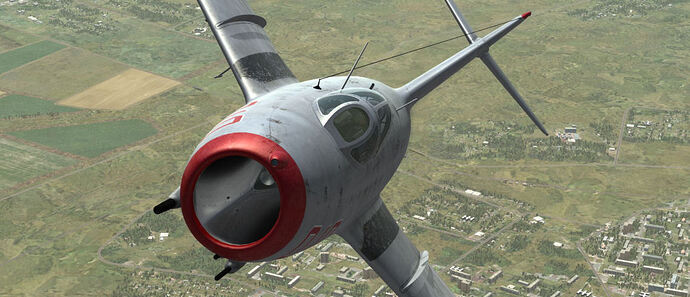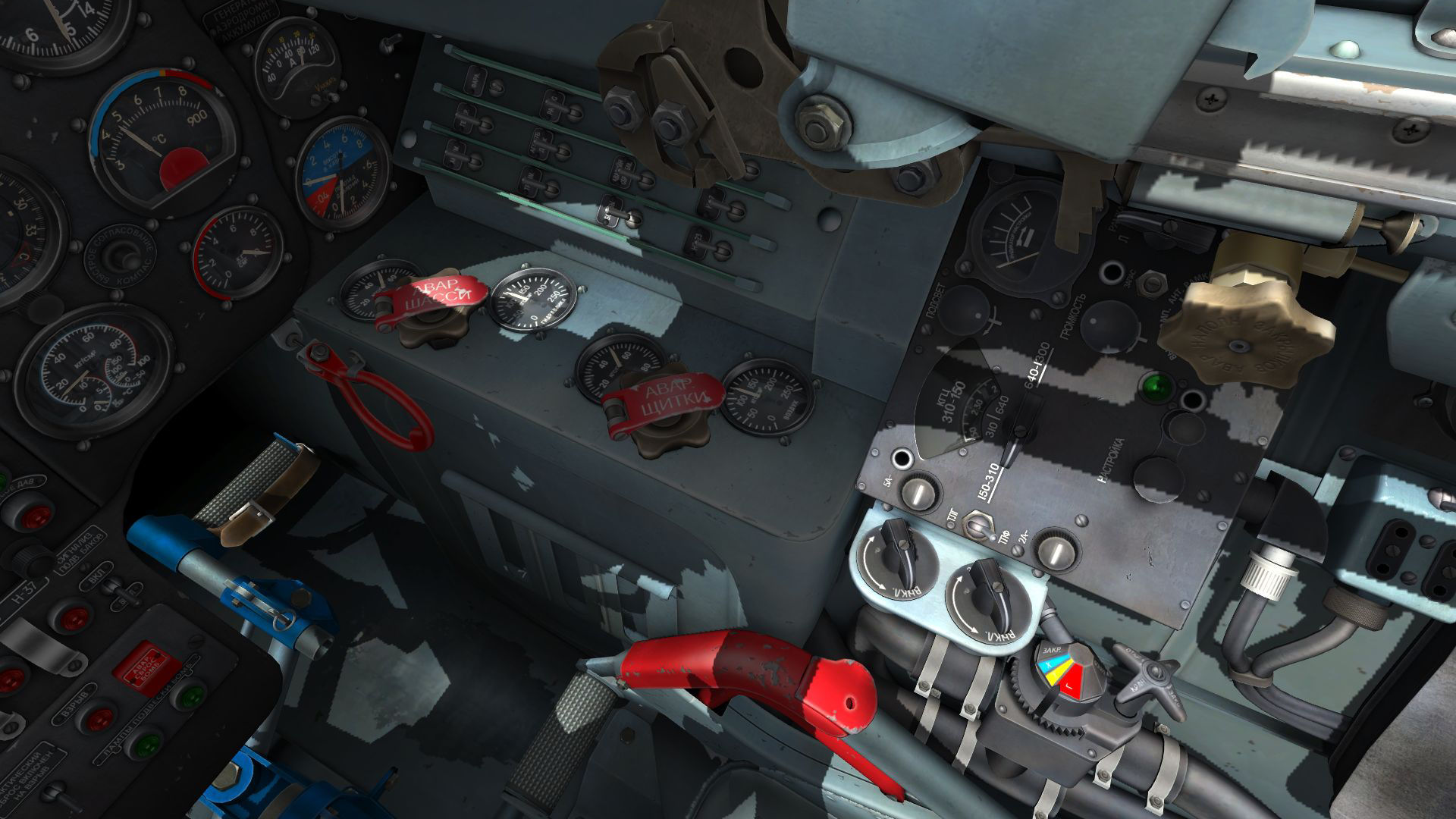Preview of DCS: MiG-15bis
By @EinsteinEP - February 27, 2015
Originally published at: Articles - Mudspike Forums
When Eagle Dynamics announced that the beta version of the MiG-15bis was available in the open beta of DCS World, I just had to download the update and the module and fly the MiG myself. An icon of the dawn of the jet age, the MiG-15 is one of my favorite aircraft. The module is now available in the public release of DCS World.
Note: This is a preview, based on a limited pre-release beta that is believed to be a fair representative of what may eventually become the retail product. With the understanding that some features may be added, removed, or modified prior to the release, we give you this preview article which is simply a non-critical look at the features that may be included in the retail release. As usual, all material is subject to change, and all errors in content and facts are the author’s and the author’s alone.
DCS World is a free-to-play flight simulation environment that ships with two free aircraft, the Su-25T Frogfoot and the TF-51D Mustang. You can download DCS World here and pick up any additional modules you’d like here. Remember that while you can download any of the other modules for free, a paid-for activation code (aka license, aka serial number) is required for each module in order to actually play it. Only install modules for which you have an activation code.
In addition to the MiG-15bis module previewed here, there are a slew of other modules currently available for purchase at the DCS E-Shop.
The First Jet MiGs
Although the MiG-9 was Russia’s first turbojet fighter, their oldest jet-child was a disappointment. Hindered by poor engine technology and cannon gas ingestion issues, the MiG-9 was more of a jet-engine stuffed into an airframe than the idealized jet fighter. Artem Mikoyan and Mikhail Gurevich’s next jet design benefited from an unusual deal with Britian to get higher-performing engines. This extra power, swept wings, and steadily growing knowledge of high-speed aircraft design resulted in the MiG-15.
MiG-15 on display. (Courtesy of Wikipedia)The MiG-15, NATO reporting name Fagot, is a relic of when Man first started strapping on jet engines and took to the skies. The MiG-15’s first flight was in December of 1947, a mere two months after Chuck Yeager broke the sound barrier in his X-1, so aircraft designers were still learning a lot about how hot metal slides through air at the speed of Mach, but they sure knew how to make fine-looking aircraft.
The look of the MiG-15 is characteristic of the transition from WWII fighters to the jet age – all metal with lots of flush-mounted rivets, a gaping intakes for the engines, finely interconnected skin panels that seem to precisely interleave with each other, bubble glass canopies, and curves everywhere. Aircraft of this age were just dang sexy.
The MiG-15 proves that thick is in with its severely streamlined cigar body and blunted nose. The rakish angles of the swept wings complement the angled horizontal stabilizer and give the MiG-15 its classy signature look – who doesn’t like a little style with their speed?
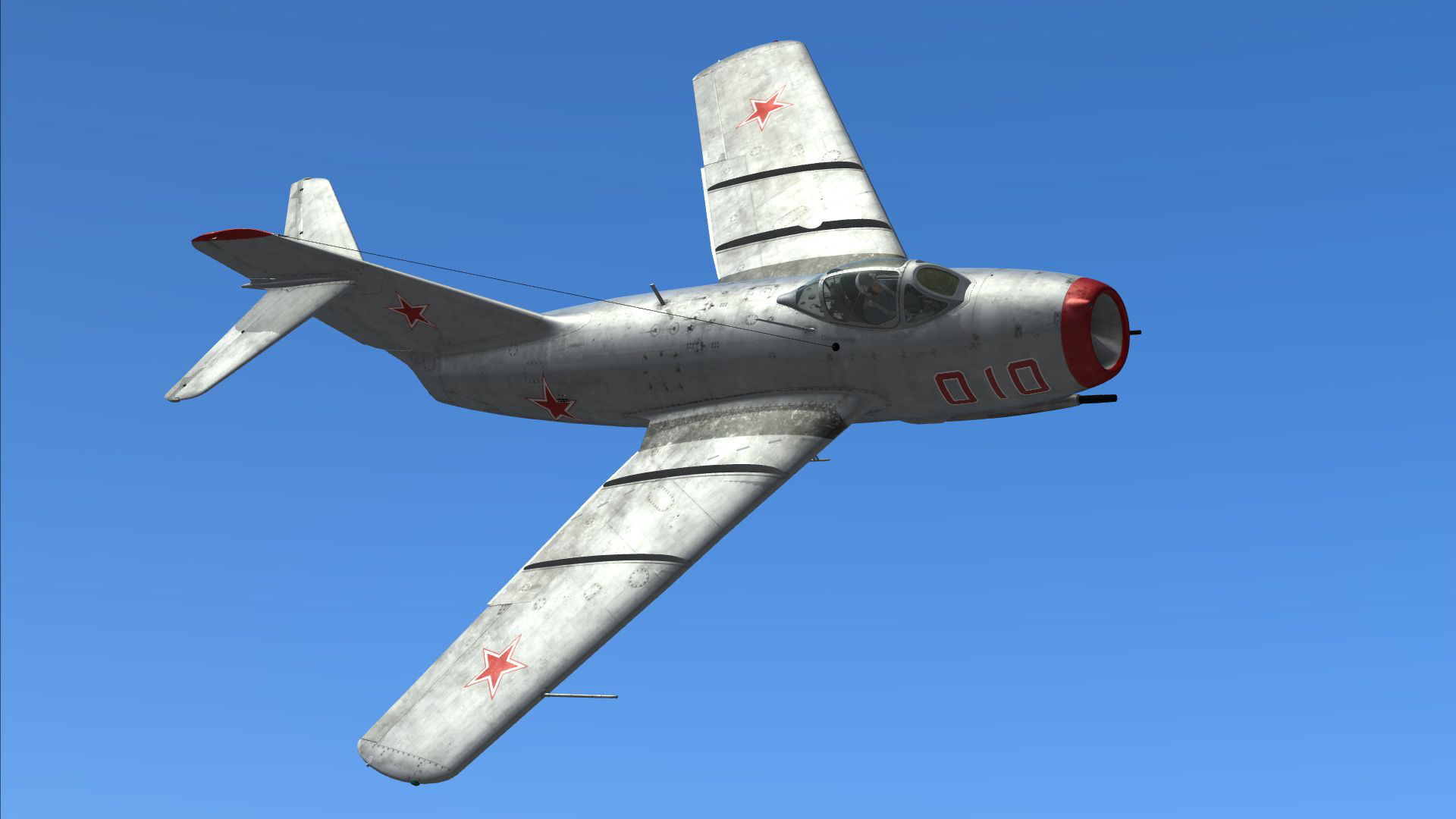 The high T tail is the characteristic give-away in a furball with Sabres and -15s.
The high T tail is the characteristic give-away in a furball with Sabres and -15s.
The two boundary-layer fences on each wing, typical for early swept-wing designs, keep airflow from getting unruly over the entire lifting surface of the wing. They also help distinguish this aircraft from the very similar looking MiG-17, which has three fences on each wing in addition to a ventral fin to improve maneuverability.
The elevators trailing on the fixed horizontal stabilizer become almost useless at speeds higher than critical Mach due to the effects of near sonic airflow, another reminder of how much we’ve learned since then.
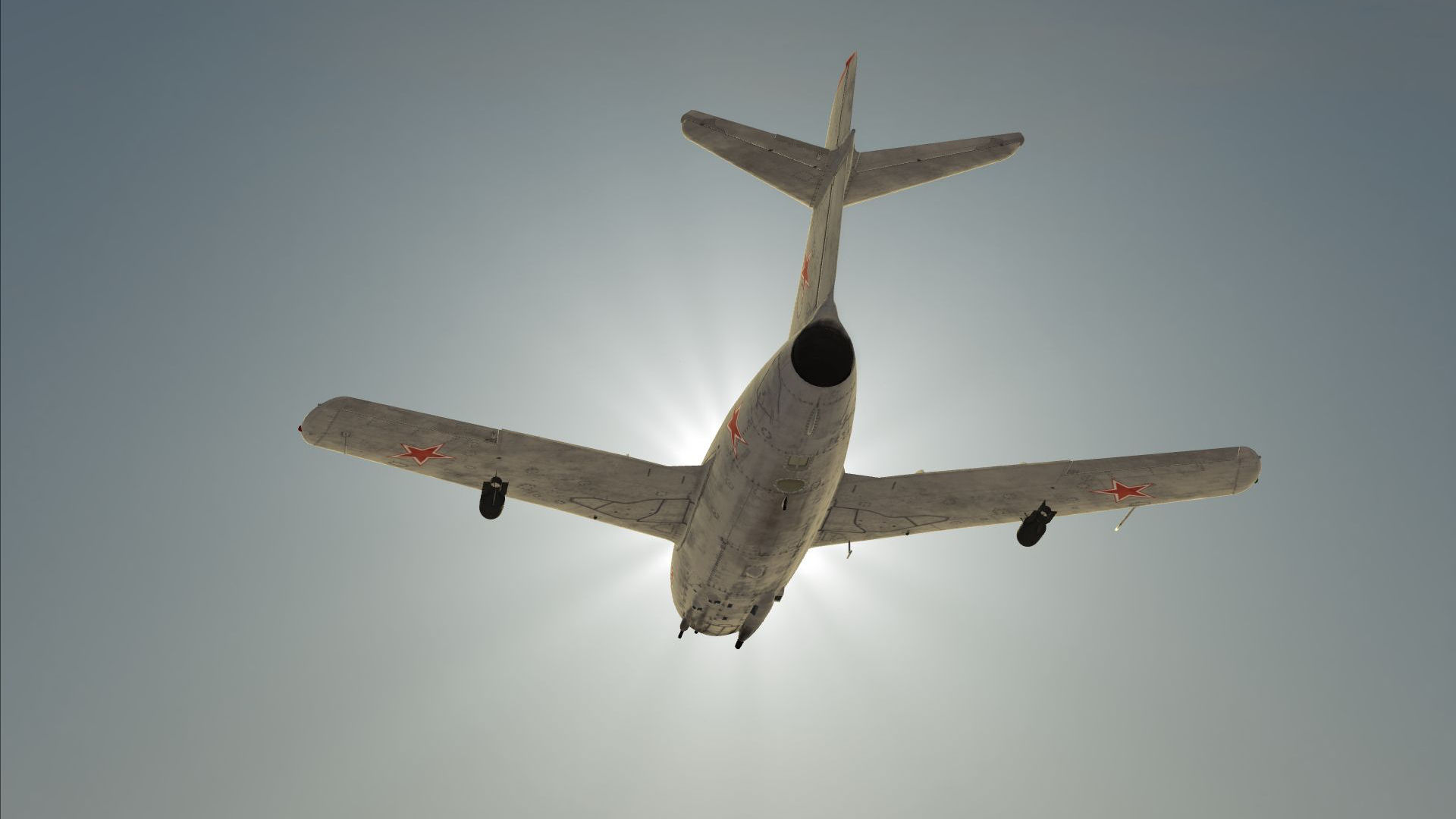 Attention to detail like this speaks volumes in terms of the developers focus and passion.
Attention to detail like this speaks volumes in terms of the developers focus and passion.
Like many aircraft of the era, configurations were not as strictly controlled or limited as they are today. For example, the plane we today call the MiG-15bis, which entered production trials in September of 1949, was called “MiG-15 with (Vladmir Klimov) VK-1 engine” up until 1951. Even within the bis there were many configuration changes – later models had the landing light moved from the nose to under the left wing and received a newer NS-37 cannon without change in designation.
A massively produced aircraft (estimated total production of more than 18,000), there any many different variants that were produced by a number of factories across Russia, Poland, China, and Czechoslovakia – way too many to review here!
External Models
Belsimtek‘s MiG-15bis model captures the character of this jet-age pioneer perfectly. The highly detailed skin texture, animated landing gear doors that are half art, half mechanical engineering marvel, and split flaps, which seem out of context on a high-performance jet fighter. Crude and stubby radar altimeter antennas (antennae?) at asymmetrical locations on the wing serve to remind us just how close to WWII this aircraft was designed and built. The 22-degree upswept airbrakes which debuted on the MiG-15bis are present, but the nose-mounted landing light indicates that Belsimtek selected an early model bis.
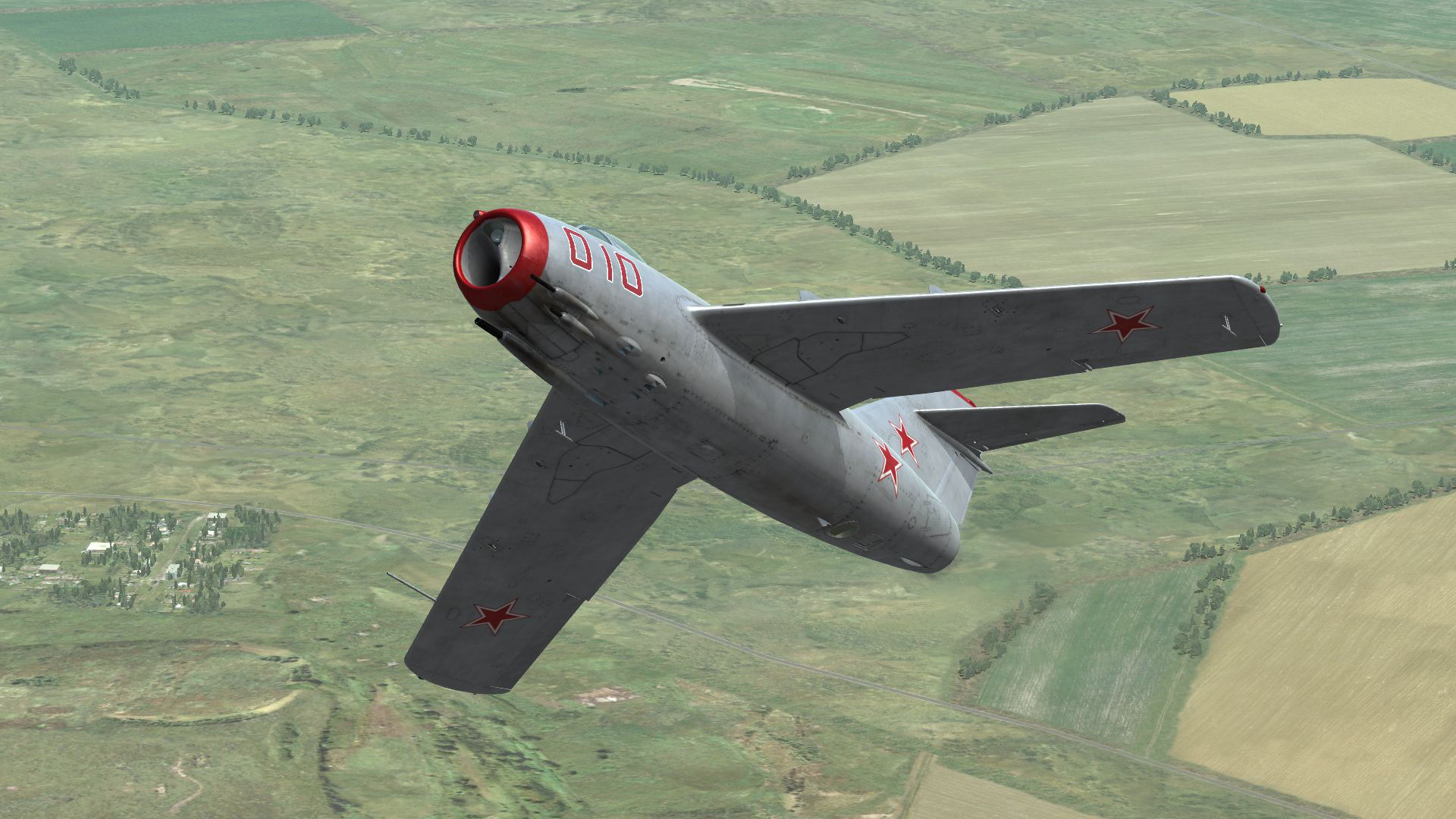 Rolling over to show its belly is not always an invitation to rub.
Rolling over to show its belly is not always an invitation to rub.
The metal texture gleams under the sun with a strong specular reflection – beautiful to behold.
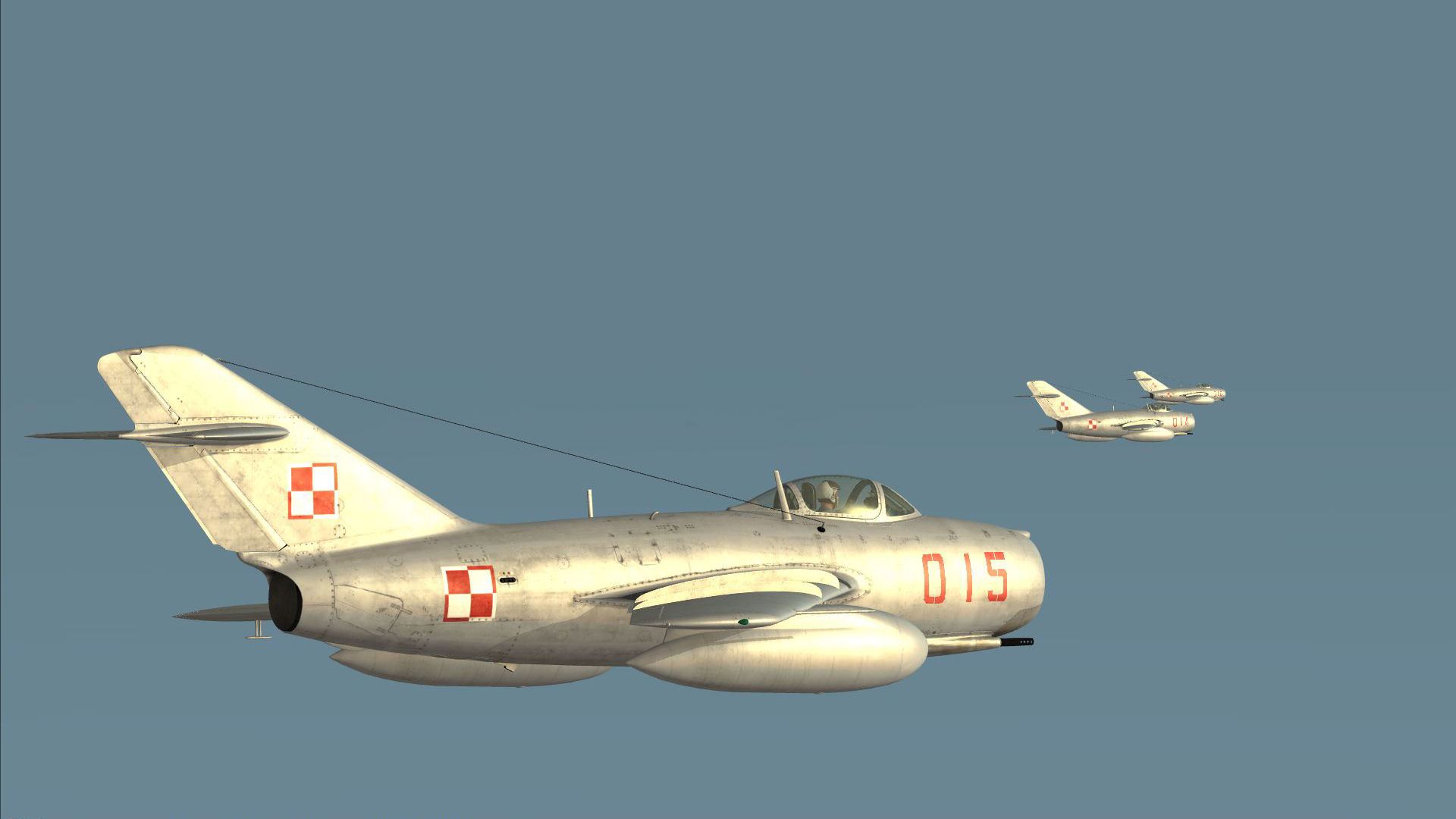 One can help but wonder what this will look like in DCS World 2.
One can help but wonder what this will look like in DCS World 2.
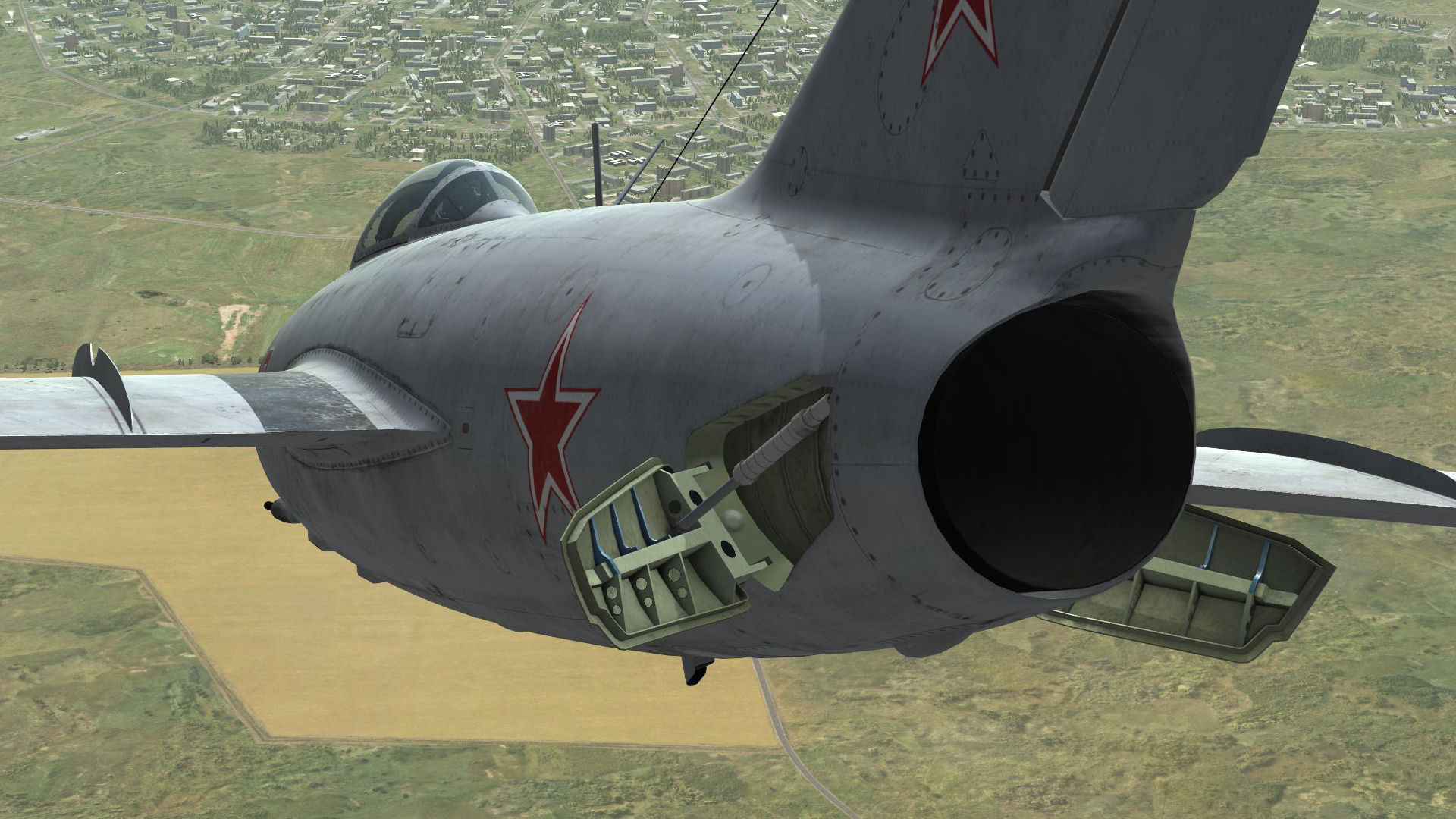 The airbrake design is new for the MiG-15bis and automatically retract when the pilot releases the extend button on the stick.
The airbrake design is new for the MiG-15bis and automatically retract when the pilot releases the extend button on the stick.
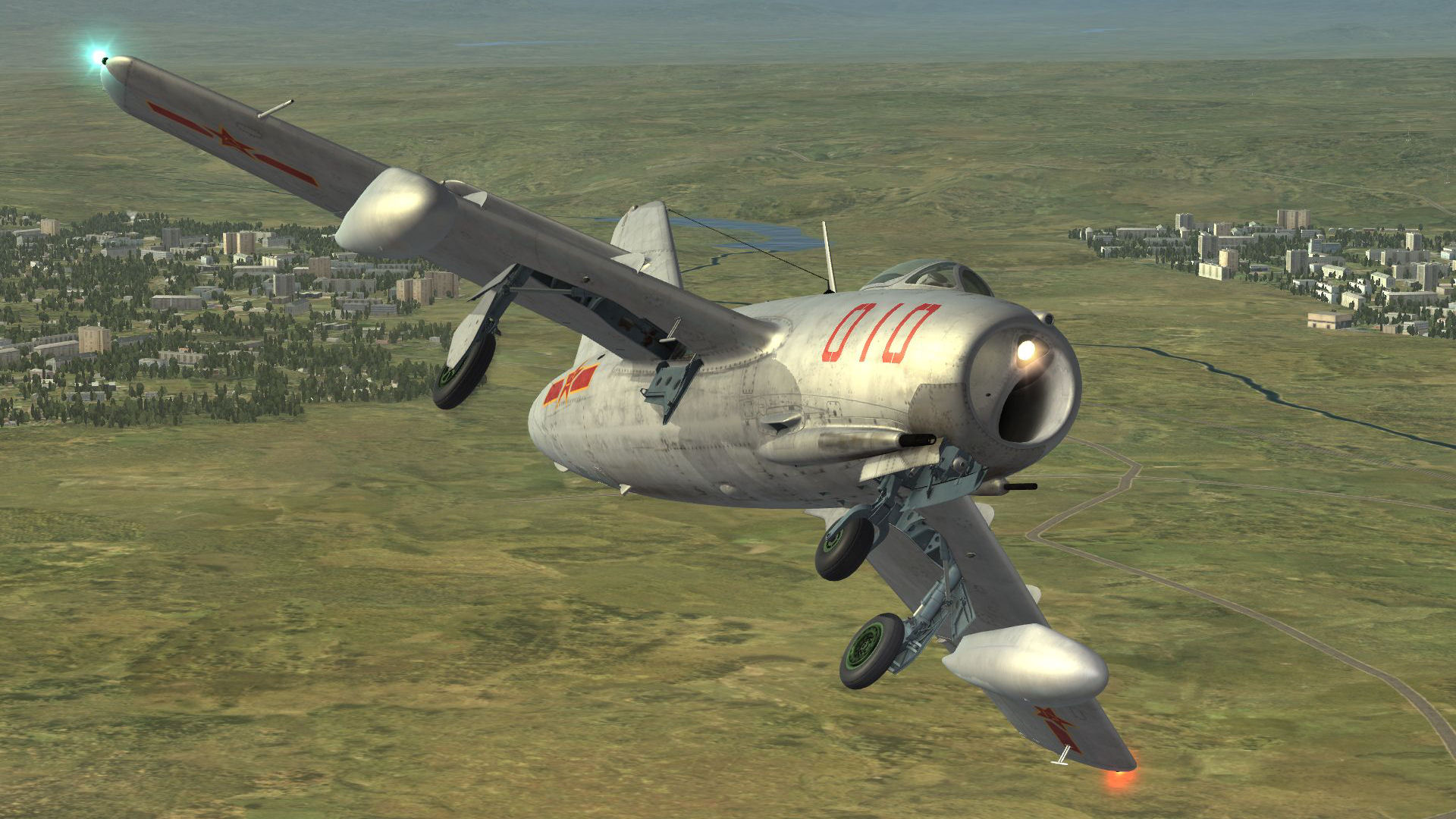 Flying (and landing!) the MiG-15bis is pure joy.
Flying (and landing!) the MiG-15bis is pure joy.
Paintjob wise, the MiG-15bis comes with a handful of liveries:
- Czechoslovak Air Force
- Korean’s People’s Air Force
- People’s Liberation Army Air Force
- Polish Air Force
- Air Forces of Soviet Union*
- North Korea – Major Arkady Boytsov*
- USSR Pepelyaev*
- USSR Red*
*Although the MiG-15bis can be flown under all countries in the DCS mission editor, the last four skins are only available for USSR planes.
Cockpit
Internally, the cockpit is a dream – chock-full of buttons and switches and dials and levers, it’s very difficult to sit in this cockpit and not run my virtual fingers over everything. I prefer to fly cockpits in their native language and I’m almost comforted by the Cyrllic lettering and familiar layout from other Russian aircraft I’ve (virtually) flown. I note that the tooltips are in English, which will be of assistance while learning the cockpit, and for helping finding the right switch in the heat of battle. I’m pleased to see this feature already implemented in a beta product.
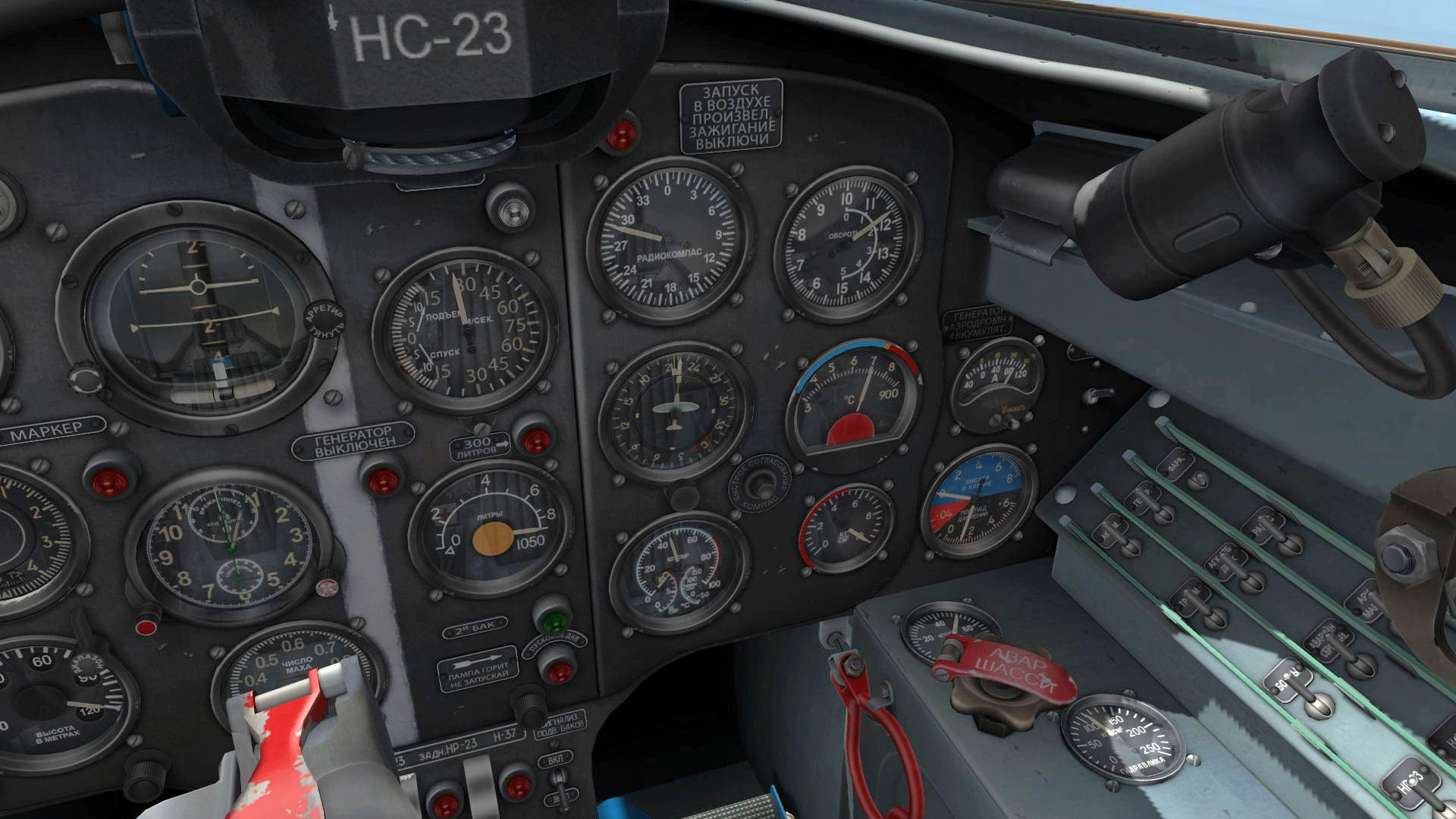 Half WWII, half jet age, the cockpit is easy to navigate and operate, even with the Cyrillic lettering.
Half WWII, half jet age, the cockpit is easy to navigate and operate, even with the Cyrillic lettering.
The attention to human engineering factors is pleasantly surprising given the age of the plane.
As one would expect from a DCS product, the cockpit is fully clickable – even the ventilation controls are operable. The MiG-15bis startup sequence is straight forward and easy, but requires some travel around the cockpit, which is always fun. The forward motion of the camera is stopped by the gunsight, really adding to the feeling of being crammed in.
Guns, guns, guns!
Designed primarily as an interceptor, it should be no surprise that the MiG-15bis doesn’t carry an impressive set of stores. With the beta release of MiG-15bis we get two different bomb types (the FAB-100M and FAB-50) and three types of wing tanks – 300, 400, and 600L varieties.
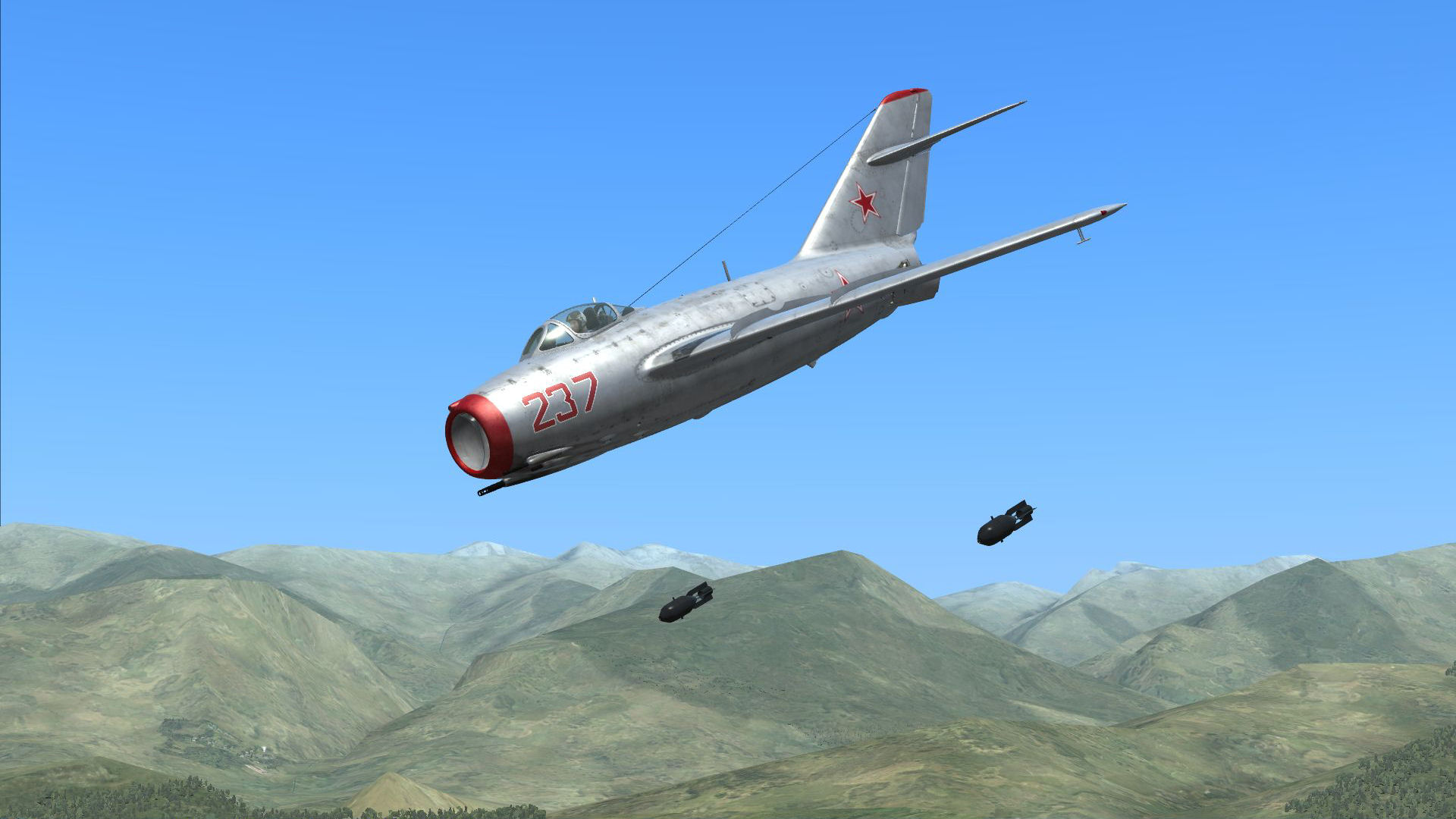 Yeah, I missed. I missed LONG.
Yeah, I missed. I missed LONG.
Without a functional bomb sight, bombing in the MiG-15bis is a matter of good ol’ Kentucky windage and experience to know just when to release the bombs and hit the target. The quickstart guide that ships with the module makes a great attempt at describing a typical routine, but nothing beats a few hours at the range.
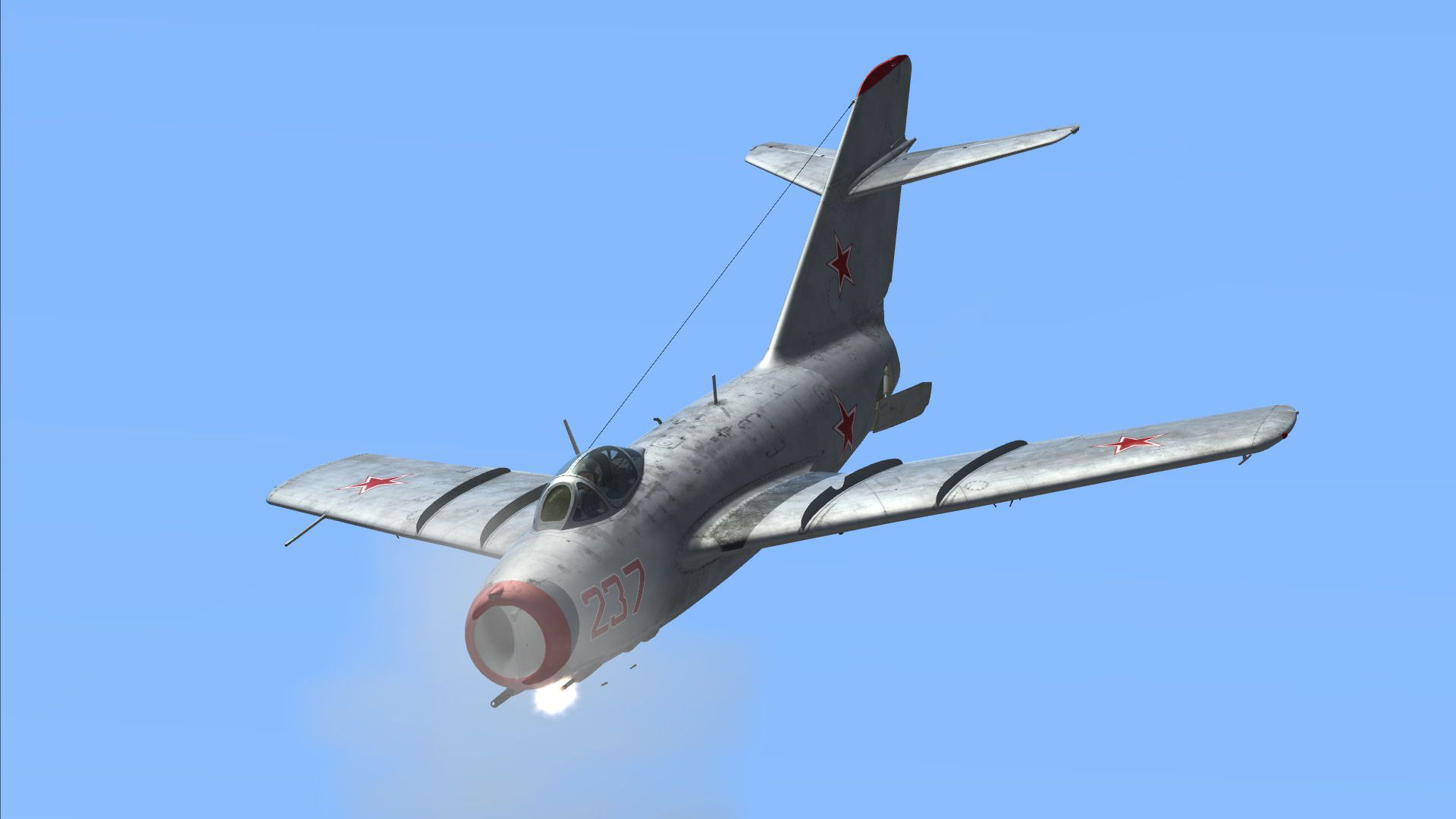 The powerful cannons work well for strafing.
The powerful cannons work well for strafing.
The guns on the MiG-15bis pack a mighty wallop, but with a grand total of 200 rounds for all three cannons, they need to! There are two 23mm cannons on the left side, one below and behind the other, and they carry a whopping 80 rounds each. The big guy, the 37 mm monster, sits on the right chin of the MiG-15bis’ nose and carries a mere 40 rounds. There are two buttons on the control stick to fire the 23mm and 37mm guns separately and I strongly recommend mapping each to easily accessible buttons.
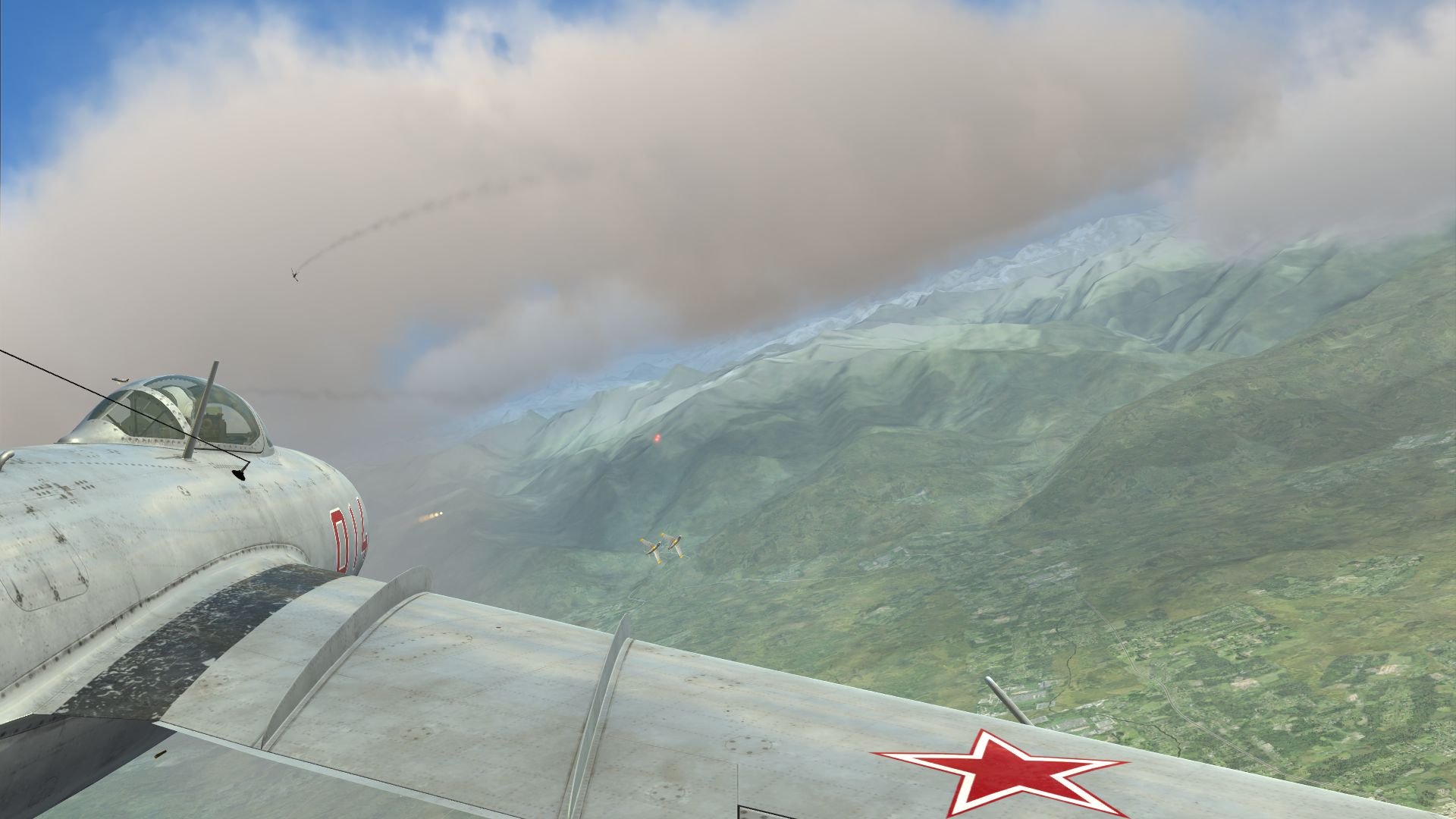 Carefully maneuvering for the shot and calmly squeezing off cannon rounds is an amazingly rewarding experience.
Carefully maneuvering for the shot and calmly squeezing off cannon rounds is an amazingly rewarding experience.
The 23mm cannon shells do significant damage on their own, but a single good hit from the 37mm is lethal for nearly any aircraft. Spray and pray is not a survivable tactic with this armament and patience in lining up your shots will be well rewarded.
On A Mission
The beta module ships with a handful of instant action missions (cold start, free flight, ground attack, intercept, and takeoff), but there are no training missions, full missions, or campaigns. This isn’t unusual for an early release, though, so hold the wringing of hands and gnashing of teeth for the release.
The intercept mission pits you against a hapless enemy plane who has witlessly strayed into the wrong part of town. The E-2, a reconnaissance aircraft, has no armament or defenses, no escort, and no chances whatsoever, even against an Korean-era fighter. I almost feel bad about trying to shoot it down.
Almost.
 A quick burst from the guns from the saddle is all it takes.
A quick burst from the guns from the saddle is all it takes.
The MiG-15 was designed and deployed as an interceptor, so this mission plays right into the MiG-15’s strengths. Your target aircraft flies much slower than yours and has a tighter turn radius – choose your attack carefully. The E2 is easily dispatched with a quick burst of 23mm rounds, or a single hit from the 37mm cannon – how few shots can you use to bring it down?
Papers, Please
A quick-start manual comes along with the module and goes over the startup checklist in great detail – more than enough for the average noob to get started on the first try (pro tip: either use the keyboard commands for the fuel shutoff lever or practice playing with the lever before you start the engine – it’s in a difficult place to see/click and doesn’t work exactly like you might think it does). Although the MiG-15bis’ cockpit is relatively simple compared to some of our other modules, I’m looking forward to a beefy manual on the intricacies of all the systems.
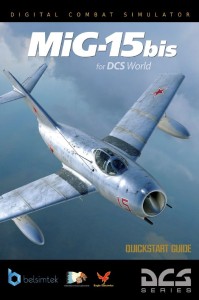 The quickstart is very well done for a beta product and has everything you need to get into the air.
The quickstart is very well done for a beta product and has everything you need to get into the air.
In addition to the high-quality quick start manual, Belsimtek has also provided an “Operating Limitations, Aerocraft Aerodynamic Particulars” document that contains a great deal of juicy information on the MiG-15bis’ performance, including takeoff and landing data, and some very interesting tidbits about roll characteristics of the airframe. Although I must admit I’m still hoping for some full-fledged performance plots and charts, I’m very pleased to see a developer providing this level of detail to our community and hope to see much more of this trend.
Flight Model
This is a beta product, so it wouldn’t be fair to assess the flight model in any detail – name a single module that NEVER took a tweak to the flight models – but in its current state, Belsimtek’s MiG-15bis is a very satisfying flying experience. The engine output lags the throttle input by a frustratingly large delay – a excellent representation of an early jet engine. The aircraft feels light and nimble at the right airspeeds – almost overpowered, rocketing up to the sky at an unbelievable angle at full power.
Although it demonstrates the technology to go fast, the MiG-15bis reminds us that we still didn’t know everything about going fast back then – the controls lose effectiveness at high-speed due to compressibility resulting in some pretty harrowing experiences for the complacent pilot. The MiG-15bis racks up airspeed in a dive quickly, so failure to watch gauges in a dogfight can turn deadly in a couple different ways.
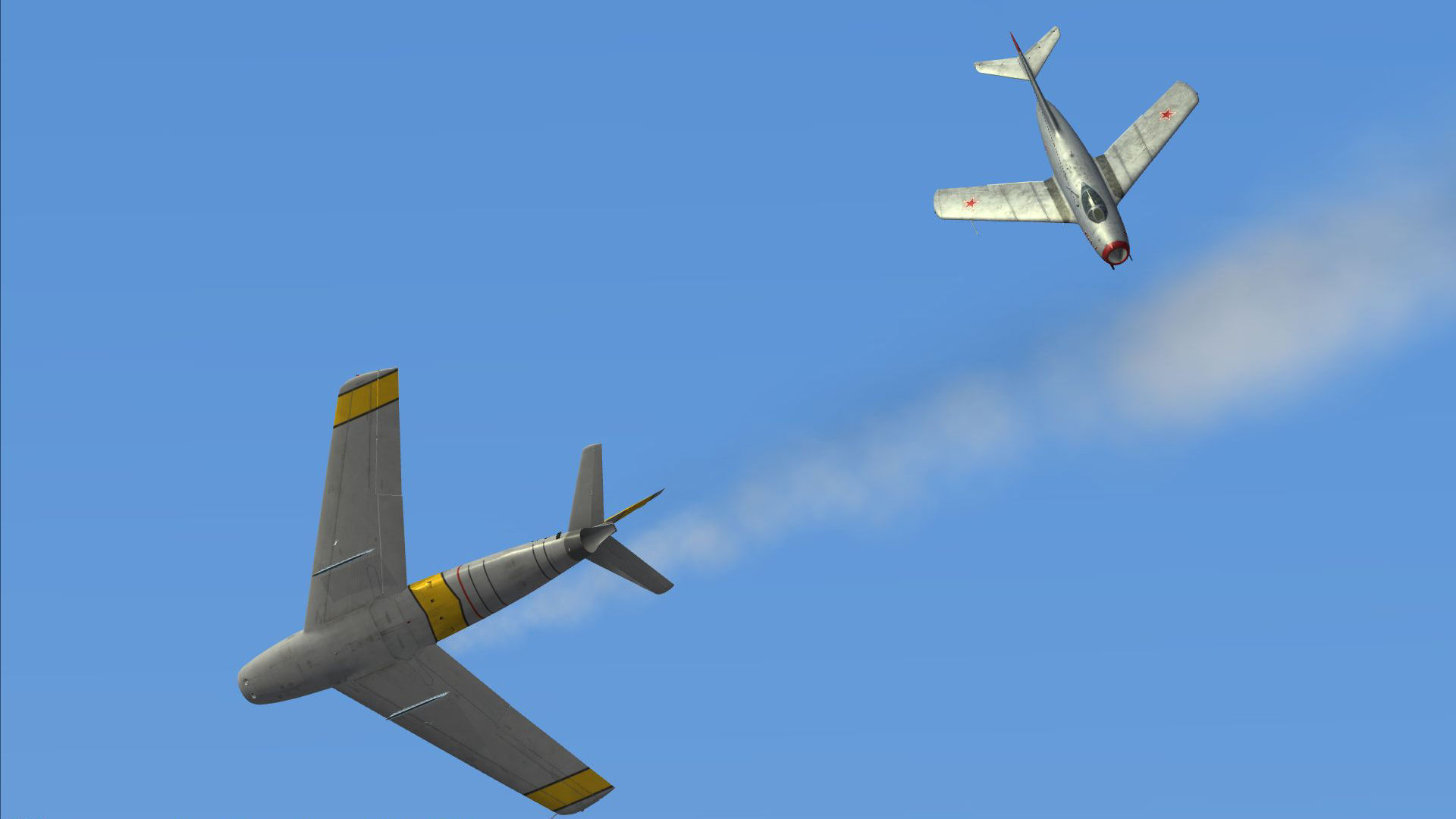 You spin me right round, baby, right round.
You spin me right round, baby, right round.
Dogfighting the MiG-15bis’ mortal enemy, the F-86F Sabre, is an exhilarating experience. The two aircraft are matched to within pretty close tolerances of each other – knowing your strengths and your enemies weaknesses can help you get that much needed edge. Keeping an eye on altitude and airspeed and being able to manage your energy really pays off.
Sound
Sounds in simulations are a thankless job – do it right and nobody notices, screw up and suddenly everybody is an expert – but is critical for immersion. The engine, environment, and ambient sounds of Belsimtek’s MiG-15bis are thoroughly satisfying, both inside and outside of the cockpit.
The cannon sounds are gorgeous, with the thumps from the 37mm practically rattling my desk. If you’ve got a decent sound system, crank it up for the 37mm cannon for a good ride! Just make sure you warn your neighbors, first.
Conclusion
Currently out for beta at $49.99 USD from Eagle Dynamic’s E-Shop, the MiG-15bis is a hefty purchase, especially for a beta, but the MiG-15bis is an unmistakable icon of the jet age. If Belsimtek’s previous work is any example, this module will do its legacy justice.
